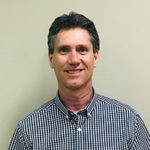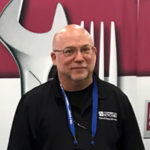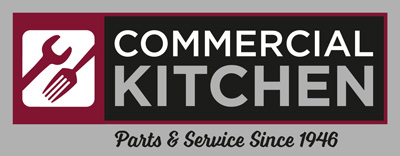by Commerical Kitchen | Industry

Commercial Kitchen Houston.
SINCE 2013, Commercial Kitchen Parts & Service had only offered service in the Houston market, until now. Many of our customers being served in Central and South Texas have requested the same types of services and products out of Houston.
Seeing the demand, Commercial Kitchen has now opened a full parts store in order to fully service the Houston market and support our field technicians in the same way they do with their customers in San Antonio, Austin and McAllen. In the past, the parts in Houston were only available to Commercial Kitchen’s own field technicians, but those parts are now available for over-the-counter sales. Stock includes the “basics:” gas hoses, common switches, knobs, bulbs, commercial plumbing fixtures, and specific electrical items (high-temperature wiring, connectors, etc.). As local needs are identified, stock will continue to be built up to service the local area in the best ways possible. As with our other locations, Commercial Kitchen will offer a wide range of replacement parts for commercial kitchen equipment.
The OEM replacement parts inventory that Commercial Kitchen keeps on hand is one of the largest in Texas. Our Counter Sales Reps have decades of experience in the industry and are able to offer unrivaled expertise. For emergency needs, representatives are on call 24/7/365. Since Commercial Kitchen partners with all major manufacturers, no matter what your issue might be, it is just a phone call away from being solved.
For more information about Commercial Kitchen and what we can do for you and your business, contact 800-292-2120 or service@commercialkitchen.com.
by Vidal Muñoz | Industry

By Vidal Munoz, Director of Branch Operations
With the rising of food cost and labor, restaurant managers have some difficult decisions to make when it comes to repairing equipment. The hourly rate and fees vary wildly in the repair industry. Shrinking profit margins make it increasingly important for managers to make wise choices concerning repairs. After all, when a key piece of equipment goes down, it can throw a wrench into the entire operation. Quick and cheap DIY repairs are an attractive option, but they are not always the best one. Can you afford to cause further damage to an expensive piece of equipment just to save a few dollars on the front end?
When I started in this business over 20 years ago, most equipment was relatively simple to repair. The controls were fairly simple and utilized what we would consider “basic mechanical controls”. There were only a few pieces of equipment in the industry that one could consider truly “high-tech”. In the modern commercial kitchen, however, most equipment falls into that category. Modern equipment have touch screens, PLC’s (programmable logic controllers) and computer boards. Today, the repairs often involve software upgrades, certifications, and special training.
With that in mind, the decision on who to call for the repair can be difficult. Everyone seems to know someone who is handy with tools. In fact, electricians and others may be effective in some repair settings. Given the complexity of the repairs on today’s modern equipment, however, there is a risk that more damage could be done than good. So before making that next service call, it is good to ask yourself two questions:
- Is my service company certified to work on this piece of equipment?
- If they encounter difficulties, what resources do they have to affect a repair?
Keep in mind that the majority of equipment manufacturers have already set up a national service network to handle warranty service calls. After the warranty period many have other service options. But keep in mind that your local Authorized Service Agent (ASA) has access to resources those other companies do not have. For instance, they are given equipment specific training long before the equipment hits the market. They are often required to maintain part stock levels that Company “B” is not. As an ASA they are subject to yearly audits by the manufacturers and associations they belong to. They voluntarily hold themselves to extremely high standards. Not maintaining these standards often result in serious consequences. Not all service companies hold themselves to that.
The next time a “key” piece of equipment fails in your kitchen, consider what the repairs will consist of before picking up the phone to make a service call. It is always good to have several options when it comes to equipment repair, but it is increasingly important that we make the RIGHT call.
by David Duckworth | Company Culture, Industry

By David Duckworth, Director of Corporate Operations
One of the biggest challenges the food equipment repair industry faces is finding qualified people who can perform the service work. We need technicians that are trained in the basics of electricity, gas, steam, and/or refrigeration who have both mechanical and people skills. Unfortunately, those individuals are very hard to find unless they are coming from another service company and even then we still have to train them our way of doing things. Unfortunately, even after that onboarding, we still have not added someone new to the industry, which results in a net zero gain.
In 2001 we were in dire need of technicians to keep up with our growth. Knowing we would not be able to find people with those qualifications easily. Commercial Kitchen made the decision to try something new: we would train and develop our own technicians internally and pay them to learn. We wanted to teach people the Commercial Kitchen way of performing service from the ground up. We decided to call it Commercial Kitchen University (CKU).
We ran ads searching for people interested in starting a new career. We used a testing program, from a company called Wonderlic, which tested their cognitive skills, personal traits, and mechanical skills to ensure they were the right fit for the program. Once we selected the people who met the qualifications, we followed our normal hiring process of drug screening and background checks. As a member of the Commercial Food Equipment Service Association (CFESA), Commercial Kitchen has access to certification training material for electricity, gas, and steam and we used those materials for our classes.
The CKU program lasts 12 weeks. The first section of the class is critical, teaching the electric portion. After two weeks of studying electricity we tested the students. If the students pass the written exam they were allowed to continue with the program. If they failed they were let go. We wanted them to take the program serious. We were investing a lot of time and money in them. We then moved through the other disciplines of gas and steam. We also included customer service skills and made arrangements with factories to come and train on their specific equipment. We started with 12 people and after 12 weeks we finished with 6. Three of those individuals are still working for us today. Some of them that left us are still in the business and buying parts from us. Everyone agreed the program was a success. We took a break on the program for a while. In 2006 we started talking about restarting the program and developing it into a normal recurring class. We also wanted to centralize all of our training and development into one department. I was promoted to Director of Field Operations and Training/Development in 2006. In 2007 we relaunched the program and graduated 7 technicians.
Over the last 12 years, we have made improvements to the program, including reducing the number of students per class and holding two classes a year rather than one. We have developed work books, power points and hands on training modules, and a variety of equipment to teach with. Since the 2007 relaunch we have graduated over 20 technicians. Charles Moreland was added as the Technical Trainer for the program. He was one of the graduates from the first class in 2001. In 2019 we have one class scheduled starting on August 12th.
It has been great to watch these people develop into great technicians. They now have a skill they can use for a long career in the food service repair business.
by Bill Leader | Industry

By Bill Leader, Sales Manager
Original equipment manufacturer (OEM) parts are, perhaps, the best option for individuals and companies who need to make repairs. Unfortunately, given the unplanned nature of failure on important pieces of equipment (especially in commercial kitchens), managers and service companies will often opt to take the quicker route of using generic parts for the repairs that need to be made. The utilization of OEM parts not only increases return on investment (ROI), but it also reduces liabilities and the chance of future failure of the equipment in which it is being installed.
Cost wise, OEM parts are not the cheapest thing you can get. However, as the old adage goes, you get what you pay for. There is an inherent pressure on owners and managers to see a reduction in their operational costs, and that pressure often leads to corners being cut. The first corner that gets cut, in many cases, is replacing broken parts with generics rather than OEM parts. Though going OEM can be a bit more expensive up front, it brings value to the table in terms of reduced liability and by alleviating future risk of failure. OEM parts are warrantied and must go through quality control (QC) checks to ensure proper functionality.
There are additional risks with generic parts that do not make themselves readily apparent. On the outside, the parts may look exactly the same, but on the inside, there could be faults or cheaper components used. This could lead to problems with other parts of the system, including negative effects on related parts. The system failures that could potentially result from those effects are simply not worth the risk. Generics bring that inherent liability any time they are installed. This is not to say they are never an option, but it does mean that they should be considered a backup option at best.
ROI is typically the first thing people look at when they are determining how to proceed with business decisions (especially when it comes to parts or equipment). Unfortunately, many do not look past the initial price tag when determining what to buy. In the long run, OEM parts are the better value and, thus, offer the better ROI. The initial price tag on those OEM parts, which is higher than most generics, is often enough to turn people off of buying them. Those same people are running the risk of future system failures, faulty parts, performance loss, and the potential of a negative impact on ancillary parts.
Ultimately, OEM parts provide the best ‘bang for your buck’. You are getting a warrantied piece of equipment that is guaranteed to work with the equipment it is being used on. Installation is a simpler procedure. The average lifespan of OEM parts is longer, increasing the time between equipment failures. The fact that certifications and warranties remain in place and that risk is lowered is just the icing on the cake. The use of generic parts may be appealing at the outset but considering all of the ancillary factors that play a role in the buying decision, OEM is simply the best way to go.
by David Duckworth | Company Culture, Industry

By David Duckworth, Director of Corporate Operations
The Commercial Food Equipment Service Association (CFESA) is a professional trade association comprised of companies who perform service and distribute parts for commercial foodservice equipment manufacturers. The membership is comprised of companies all over the world, but primarily located in the United States, Canada, and Mexico. CFESA places importance on training, sharing of resources, best business practices, and helping create the standard for training used throughout the industry. Their goal is to drive service excellence in the industry.
Of the over 400 members that make up the CFESA organization, a select few have managed to reach the top tier, becoming a Certified CFESA company. Only around 30 or so companies have reached this level of excellence within the association. The process of becoming a Certified CFESA company is stringent. Not only that, but a Certified company will only remain at that level for 3 years before they need to renew that certification. It is sometimes harder to maintain the certification than it is to attain it.
Becoming CFESA Certified is not a simple task. There are a number of criteria which must be met, all of which are graded on a point system during the review process. To begin with, 75% of the business done by the prospective company must be based around parts and service. Second, the company must have been in business and in good financial condition for at least 72 months. The prospective company must also be a voting member of CFESA in good standing before they are eligible to begin the certification process.
The certification has requirements in 5 areas including: financial, education & training, industry participation, industry relations and professionalism. These criteria are measured and calculated using a stringent point system. Here are some of the criteria in more detail:
- Training and Education Standards – This area includes levels of certification on electric, gas, steam, and refrigeration. All technicians employed over 2 or more years must have at least 2 of these CFESA certifications. At least 25% of technicians must be “master technicians”, meaning that they have certifications in three or more of the categories. Technicians must also complete a minimum of two Manufacturer specific trainings within a 3-year period.
- Participation Standards – This area includes regular attendance at CFESA national conferences, speaking at any of the industry conferences, and contributing to the association on one of the various committees. Additionally, contributing to the CFESA magazine and membership on CFESA Board of Directors can also count toward certification.
- Professionalism – A minimum level of insurance is required, and the company must demonstrate it is in sound financial condition. Each office must have a posted mission statement. Stationary, vehicles, emails etc. must have the CFESA logo included to help with brand recognition. All work must carry a 90-day parts and labor warranty.
- This list is far from complete, but goes to show the level of commitment that a company must have in order to attain and maintain the Certified CFESA status. Commercial Kitchen has proudly been a CFESA Certified company since 2004 and just completed the renewal process earlier this year.
Commercial Kitchen Parts & Service is committed to providing fanatical service and unrivaled expertise. Achieving and maintaining the CFESA Certified company status is an example of that commitment.
by David Duckworth | Industry

By David Duckworth, Director of Corporate Operations
You have just found that the transformer on a piece of equipment is not producing any voltage on the secondary side, also known as the load side. You check the primary side and you find the correct voltage supply. So you install a new transformer and you’re done, right?
WRONG! You will probably be replacing the new transformer immediately!
A transformer typically does not fail on its own; some other situation or component has caused it to fail. You need to find that problem before changing the transformer.
The majority of transformer failures can be attributed to excessive overloads due to a short circuit on the secondary, or load, side of the transformer. When this load increases, it produces excessive heat beyond the capability of the transformer. This heat buildup breaks down the insulation between the windings, and the transformer eventually burns out, or as we say in the business, “smokes.”
Another reason the transformer may fail is contamination. The transformer can be in a wet or corrosive environment, which may also lead to a breakdown in the insulation of the windings.
Your first step before replacing the transformer is to check the circuitry for any signs of a short circuit to ground and use your ohmmeter to inspect all magnetic coils on contactors, relays, and solenoid valves for any breakdown in resistance. If there is an obvious shorted wire or coil, first correct the problem and then install the new transformer.
If you are not sure what caused the transformer to fail, you will need to temporarily fuse the new transformer. An in-line fuse holder will need to be installed in-line with the hot wire coming off the secondary side of the transformer. Use only fast-blow fuses. You will use a process of elimination to find the problem. Disconnect each component powered by the transformer. Reapply power to the transformer and confirm you have power out of your secondary side. Then start to reconnect each component until the fuse blows. The last part you connect is generally the cause of the transformer failure, and that component will also need to be replaced before replacing the transformer. Remember, it is cheaper to replace a few fuses than a few transformers!
To properly fuse the transformer for the load capability, take the VA rating of the transformer and divide it by the side you are trying to protect.
Examples:
Primary side 60 VA ÷ 120 volts = .50 = ½-amp fuse
Secondary 60 VA ÷ 24 volts = 2.5 = 2½-amp fuse


